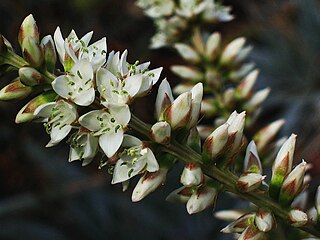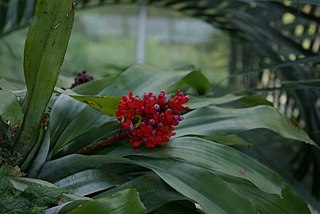Related Research Articles

The Bromeliaceae is a family of monocot flowering plants of 75 genera and around 3590 known species native mainly to the tropical Americas, with a few species found in the American subtropics and one in tropical west Africa, Pitcairnia feliciana.

Puya is a genus of the botanical family Bromeliaceae. It is the sole genus of the subfamily Puyoideae, and is composed of 226 species. These terrestrial plants are native to the Andes Mountains of South America and southern Central America. Many of the species are monocarpic, with the parent plant dying after one flower and seed production event.

Hechtia is a genus of plants in the family Bromeliaceae, and is the sole genus of the subfamily Hechtioideae, containing 75 species. Its species are native to Mexico, Central America, and Texas.

Bromelia is the type genus of the plant family Bromeliaceae, subfamily Bromelioideae. Bromelia species are widespread across much of Latin America and the West Indies, and are characterized by flowers with a deeply cleft calyx. The genus is named after the Swedish medical doctor and botanist Olof Bromelius (1639-1705).

Werauhia is a genus of the botanical family Bromeliaceae, subfamily Tillandsioideae. The genus is named for Werner Rauh, a German botanist (1913–2000). Based on molecular evidence, a number of species previously classified within other bromeliad genera, especially Vriesea and Tillandsia, have been placed in Werauhia instead.

Vriesea is a genus of flowering plants in the botanical family Bromeliaceae, subfamily Tillandsioideae. The genus name is for Willem Hendrik de Vriese, Dutch botanist, physician (1806–1862). Its species are widespread over Mexico, Central America, South America and the West Indies.

Aechmea is a genus of flowering plants in the family Bromeliaceae. The name comes from the Greek aichme, meaning "spear". Aechmea comprises eight subgenera and around 250 species distributed from Mexico through South America and the Caribbean. Most of the species in this genus are epiphytes.

Fosterella is a genus of plants in the family Bromeliaceae, subfamily Pitcairnioideae. It contains 31 recognized species, 30 native to central and western South America, one to Mesoamerica. The genus is named after Mulford B. Foster, American horticulturist and collector (1888-1978).

Billbergia is a genus of flowering plants in the family Bromeliaceae, subfamily Bromelioideae. The genus, named for the Swedish botanist, zoologist, and anatomist Gustaf Johan Billberg, is divided into two subgenera: Billbergia and Helicodea. They are native to forest and scrub, up to an altitude of 1,700 m (5,577 ft), in southern Mexico, the West Indies, Central America and South America, with many species endemic to Brazil.

Deuterocohnia is a genus of plants in the family Bromeliaceae, subfamily Pitcairnioideae, endemic to South America. The genus is named for Ferdinand Julius Cohn, Jewish botanist and bacteriologist.

Pothuava is a subgenus of the genus Aechmea.

Dyckia is a genus of plants in the family Bromeliaceae, subfamily Pitcairnioideae.

Pitcairnia is a genus of plants in the family Bromeliaceae, subfamily Pitcairnioideae. It was named for Dr. William Pitcairn, Scottish physician and gardener (1711–1791). The genus Pitcairnia ranks as the second most prolific of the bromeliad family. They are most abundant in Colombia, Peru and Brazil, but can also be found in areas from Cuba and Mexico south to Argentina. One species, Pitcairnia feliciana is found in tropical West Africa and is the only member of the family Bromeliaceae not native to the Americas.

Hohenbergia is a genus of plants in the family Bromeliaceae, subfamily Bromelioideae. It is native to the West Indies, the Yucatán Peninsula, and northern South America.

Nidularium is a genus in the plant family Bromeliaceae, subfamily Bromelioideae. Named to describe the nestling characteristic of the inflorescence, all the species are endemic to Brazil. Commonly confused with Neoregelia which they resemble, this plant group was first described in 1854.

Lamprococcus is a subgenus of the genus Aechmea.

Platyaechmea is a subgenus of the genus Aechmea.